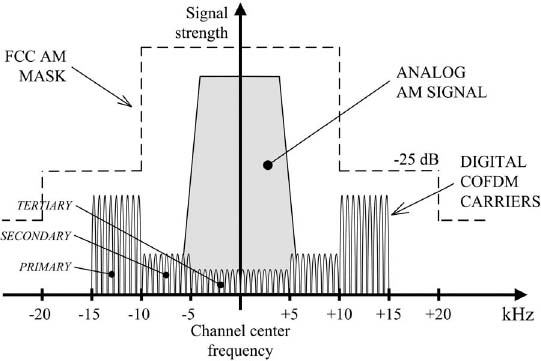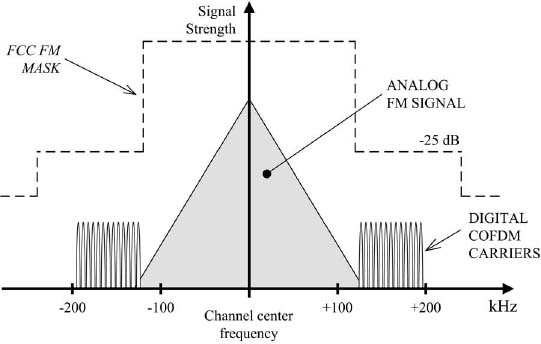IBOC Digital Radio
In-Band, On-Channel (IBOC) digital radio is a new radio technology that is currently being deployed in the United States, whereby a digital signal is combined with the signal from an analog station. The name IBOC indicates that the digital service shares the same band and channel as the analog service. The AM and FM band IBOC systems being deployed in the United States, called HD Radio, were developed by iBiquity Digital Corporation. Following a rigorous evaluation by the National Radio Systems Committee (NRSC), completed in early 2002, the FCC in October 2002 approved HD Radio technology for use under an interim authorization. This allows FM broadcasters to transmit IBOC 24/7 but restricts AM transmissions to daytime-only use. At the time of this action, very little technical information was available about how AM IBOC would perform at night in the more difficult skywave propagation environment (see Chapter 17 for more on propagation).
In the first part of 2003, iBiquity made some changes to the specifications for the audio compression system, and stations started to broadcast using the new audio codec (called HDC) later in 2003. The FCC issued a Further Notice of Proposed Rulemaking and Notice of Inquiry on IBOC in April 2004. This sought comments on various questions related to IBOC deployment, and the industry replied with generally constructive and positive inputs. The next logical step in this process will be for the FCC to issue final rules on IBOC implementation.
The HD Radio system provides stereo digital audio services using the same frequencies as existing AM and FM radio stations. There are two versions of IBOC—for AM and FM. They provide similar capabilities, although the technical details vary. Characteristics that are common to both systems are described as follows.
Phased IBOC Introduction
IBOC is designed to be introduced in two phases—hybrid and all-digital—enabling a smooth evolution from the current analog services.
Hybrid Phase
The initial hybrid phase adds a digital service to the existing analog service, with identical audio programming (i.e., simulcasting) and some optional data services (which may include additional audio channels). This provides simultaneous analog and digital services to the same principal coverage area. Because the digital portion of the IBOC signal is at a much lower power level than the analog portion, as listeners approach the edge of the coverage area, the digital signal becomes unusable, and the IBOC receiver at that point blends from the digital to the analog signal. This avoids the abrupt reception failure that would otherwise occur (the so-called cliff effect).
During the hybrid phase, listeners may continue to use their existing receivers for the analog audio service or may purchase digital receivers for the digital audio and new data services. The new digital units can receive stations that are transmitting analog-only services, as well as those with IBOC services, which, as just mentioned, may blend from analog to digital depending upon signal reception conditions.
All-Digital Phase
At some point in the future, when IBOC receiver penetration is sufficient, broadcasters will be in a position to implement the all-digital phase. At that time, the analog signal will be turned off and the digital signal enlarged (but still within the FCC mask). This maximizes the coverage area and will provide capacity for additional data services. Currently, the FCC does not allow broadcasters to utilize this mode of operation.
In the all-digital mode, two audio streams are fed from the same audio source. One robust stream provides the basic audio quality, but both streams are needed to provide the full quality. Thus, at the edge of the service area, the system can drop back from full to basic quality, avoiding the annoying cliff effect.
Carriers and Channels for IBOC
For hybrid IBOC, the digital service is achieved by placing additional carriers in the sideband areas above and below the analog signal of the associated AM or FM station. These carriers are arranged in a special way so as to minimize the interference to the analog portion of the signal. The digital signals fall within the existing emissions masks of the AM or FM channel as described in the previous chapter. In the all-digital mode, the analog audio service is removed and replaced with additional digital carriers.
The multiple carriers of COFDM used in IBOC are frequently referred to as subcarriers, and many people use the terms interchangeably. Strictly speaking, they are not really subcarriers, because they are not modulated onto another carrier, as is done, for example, with FM stereo signals or NTSC chrominance signals.
Modulation and Forward Error Correction
IBOC uses a special type of carrier arrangement called coded orthogonal frequency division multiplexing (COFDM) to carry the digital signal (see the Modulation section in Chapter 4 for a brief description of COFDM). Its main advantage for IBOC is that, when used in conjunction with techniques such as interleaving and forward error correction (FEC), COFDM makes the signal very robust and easier to receive under difficult conditions, particularly in a moving vehicle.
Both AM and FM IBOC rely on audio compression to reduce the data rate of the digital audio to a size that can be carried in the available bandwidth. The audio codec (coder-decoder system) used for IBOC is known as HDC.
Typical uncompressed stereo audio at the IBOC standard sampling frequency of 44.1 kHz (as used for CDs) has a data rate of about 1.4 Mbps (megabits per second). This has to be reduced to no more than 96 kbps (kilobits per second) for FM IBOC and 36 kbps for AM IBOC.
HDC is based on the same psychoacoustic principles as the AC-3 system used for digital television; these are described in Chapter 15. It is outside the scope of this book to go into details, but, like most audio compression systems, HDC allows certain parts of the audio signal to be discarded, or sent with less accuracy, without significantly changing the sound heard by the listener.
AM IBOC
Sidebands and Bandwidth
The RF channel arrangement for AM hybrid IBOC is shown in Figure 13.1. The analog audio sidebands, carrying the mono analog program, extend to about 5 kHz on each side of the carrier, and the digital sidebands, carrying the digital service, extend out to just under 15 kHz. Although the term “digital sideband” is frequently used, they are not really sidebands in the traditional sense; they are actually just the areas of spectrum above and below the analog host where the digital carriers are placed. The primary, secondary, and tertiary “sidebands” carry different parts of the digital signal. As shown by the FCC AM Mask line, the digital carriers are at a much lower level than the analog signal, which helps reduce levels of interference into the analog host signal as well as into adjacent AM channels (see also Figure 12.1 in Chapter 12).
Figure 13.1. Hybrid AM IBOC RF Channel
In AM IBOC, the digital carriers are modulated using QAM (see Chapter 4). Using this technique, these carriers can also overlap the part of the channel used for the analog program service, as shown in the figure.
Nighttime Operations
The AM MF band in the United States is very congested with many stations. Because of the way AM MF signals are propagated over long distances after sunset, nighttime operation for AM stations is limited by interference from, and into, distant stations. At the time of the FCC’s interim authorization of IBOC, no technical information was available about how AM IBOC would perform at night in the more difficult skywave propagation environment (see Chapter 17 for information on skywave propagation).
Following further consideration of these issues, including limited field trials, test measurements, and extensive computer simulations conducted by iBiquity, in March 2004 the National Association of Broadcasters (NAB) made a recommendation to the FCC to extend the interim authorizations for AM IBOC services to nighttime use. While acknowledging the possibility for some interference into the fringe coverage areas of more distant stations, this recommendation concluded that the benefits to be gained for AM broadcasters and listeners far outweigh the limited interference predicted by the studies. If this recommendation is implemented, it will permit nighttime IBOC operations for all AM stations already authorized for nighttime analog broadcasts. The NAB has also asked for unexpected cases of interference to be dealt with by the FCC as they arise.
Quality and Bit Rates
Due to the presence of the digital carriers, when using IBOC the AM analog audio signal bandwidth has to be limited to approximately 5 kHz. Although analog AM stations can theoretically carry audio up to about 10 kHz, in fact most AM receivers cut off at frequencies below 5 kHz, so most listeners are not likely to notice this reduction in analog bandwidth. AM IBOC is not compatible with analog AM stereo; therefore, any AM stations still broadcasting in stereo will need to revert to mono for their analog service if they intend to broadcast IBOC.
The AM IBOC digital signal provides stereo audio at a quality comparable to existing FM radio, using audio compressed at 36 kbps. As a listener gets farther away from the IBOC transmitter, the AM IBOC digital audio signal blends from 36 kbps stereo to a 20 kbps mono signal that is carried as a more robust signal.
FM IBOC
Sidebands and Bandwidth
The RF channel arrangement for FM hybrid IBOC is shown in Figure 13.2. The analog audio sidebands extend to just under 130 kHz on each side of the carrier, and the “digital sidebands” extend out to just under 200 kHz. As shown by the FCC FM Mask line, the digital carriers are at a much lower level than the analog signal, which helps minimize interference into the analog “host” as well as the adjacent channels.
Figure 13.2. Hybrid FM IBOC RF Channel
Quality and Bit Rates
Unlike AM IBOC, no new restrictions are placed on the FM analog stereo signal when using IBOC. There is, however, an optional mode of operation for FM IBOC called extended hybrid in which the areas used for digital carriers are enlarged (toward the channel center frequency, and overlapping the analog signal area), allowing the IBOC signal to support additional data services. Although this mode not been evaluated by the NRSC, the extended hybrid mode is expected to have a minor impact on the quality of the host analog FM signal.
The FM IBOC digital main program service (MPS) provides stereo audio at near-CD quality, using audio compressed at 96 kbps.
It is possible to subdivide the 96 kbps digital signal into two or more audio streams, say at 64 kbps and 32 kbps, to provide a supplementary audio channel (SAC). The quality for the two channels can still be very good, and this gives stations the opportunity to broadcast different programs simultaneously. As compression technology continues to improve, this capability may enable stations to provide even more programming options.
IBOC Surround Sound
Demonstrations have been given of surround sound audio for IBOC, using special techniques for audio coding within the regular bandwidth available. In June 2004, SRS Labs, Inc. and iBiquity Digital Corporation announced the completion of joint testing of SRS Circle Surround® technology as a compatible surround sound format for HD Radio. Implementation of Circle Surround encoding allows radio stations to encode any content up to 6.1 channels into two-channel output for broadcast over the HD Radio system. This can be decoded at the receiver into full-bandwidth surround sound.
Digital Radio Data Broadcasting
Data Services Using Hybrid IBOC
One of the advantages that digital radio has over analog radio is an inherent ability to transmit data services along with the main channel audio signal. Both the AM and FM hybrid IBOC services support program-associated data (PAD) services, which allow for the transmission of station identification, song titles and artist names, and other program-related information; they can also accommodate other text such as weather and traffic updates. PAD information requires about 2 kbps of bit rate and can be displayed as scrolling text on a receiver’s display panel. This is similar to the information available from an RDS subcarrier (used with analog FM radio broadcasts).
For FM hybrid IBOC, it is also possible to reallocate some of the bits normally used for the main channel audio signal to support transmission of additional audio channels or auxiliary data services. Another feature of the FM hybrid IBOC system, referred to as extended hybrid, can add 50 kbps of data capacity. AM IBOC, however, is essentially restricted to transmission of the main channel audio and PAD signals due to the relatively low 36 kbps capacity of the digital carriers.
Data Services Using All-Digital IBOC
The all-digital mode of IBOC provides much more space for new data services. In the future, IBOC stations will be able to transmit user-specific or locality-based messaging (e.g., for traffic, advertisements, and more sophisticated data services). Bit rates up to about 300 kbps for FM and 4 kbps for AM are expected, depending on the data rates allocated to the audio.


